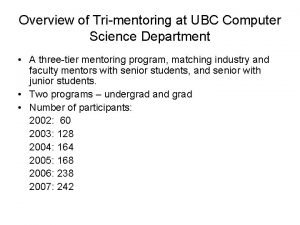HTTP Review Carey Williamson Department of Computer Science














- Slides: 14

HTTP Review Carey Williamson Department of Computer Science University of Calgary Credit: Most of this content was provided by Erich Nahum (IBM Research)

Introduction to HTTP Laptop w/ Netscape http request http response Server w/ Apache Desktop w/ Explorer § HTTP: Hyper. Text Transfer Protocol — Communication protocol between clients and servers — Application layer protocol for WWW § Client/Server model: — Client: browser that requests, receives, displays object — Server: receives requests and responds to them § Protocol consists of various operations — Few for HTTP 1. 0 (RFC 1945, 1996) — Many more in HTTP 1. 1 (RFC 2616, 1999) 2

HTTP Request Generation § User clicks on something § Uniform Resource Locator (URL): — http: //www. cnn. com — http: //www. cpsc. ucalgary. ca — https: //www. paymybills. com — ftp: //ftp. kernel. org § Different URL schemes map to different services § Hostname is converted from a name to a 32 -bit IP address (DNS lookup, if needed) § Connection is established to server (TCP) 3

What Happens Next? § Client downloads HTML document — Sometimes called “container page” — Typically in text format (ASCII) — Contains instructions for rendering (e. g. , background color, frames) — Links to other pages § Many have embedded objects: — Images: GIF, JPG (logos, banner ads) — Usually automatically retrieved § I. e. , without user involvement § can control sometimes (e. g. browser options, junkbusters) <html> <head> <meta name=“Author” content=“Erich Nahum”> <title> Linux Web Server Performance </title> </head> <body text=“#00000”> <img width=31 height=11 src=“ibmlogo. gif”> <img src=“images/new. gif> <h 1>Hi There!</h 1> Here’s lots of cool linux stuff! <a href=“more. html”> Click here</a> for more! </body> </html> sample html file 4

Web Server Role § Respond to client requests, typically a browser — Can be a proxy, which aggregates client requests (e. g. , AOL) — Could be search engine spider or robot (e. g. , Keynote) § May have work to do on client’s behalf: — Is the client’s cached copy still good? — Is client authorized to get this document? § Hundreds or thousands of simultaneous clients § Hard to predict how many will show up on some day (e. g. , “flash crowds”, diurnal cycle, global presence) § Many requests are in progress concurrently 5

HTTP Request Format GET /images/penguin. gif HTTP/1. 0 User-Agent: Mozilla/0. 9. 4 (Linux 2. 2. 19) Host: www. kernel. org Accept: text/html, image/gif, image/jpeg Accept-Encoding: gzip Accept-Language: en Accept-Charset: iso-8859 -1, *, utf-8 Cookie: B=xh 203 jfsf; Y=3 sdkfjej <cr><lf> • Messages are in ASCII (human-readable) • Carriage-return and line-feed indicate end of headers • Headers may communicate private information (browser, OS, cookie information, etc. ) 6

HTTP Request Types Called Methods: § GET: retrieve a file (95% of requests) § HEAD: just get meta-data (e. g. , mod time) § POST: submitting a form to a server § PUT: store enclosed document as URI § DELETE: removed named resource § LINK/UNLINK: in 1. 0, gone in 1. 1 § TRACE: http “echo” for debugging (added in 1. 1) § CONNECT: used by proxies for tunneling (1. 1) § OPTIONS: request for server/proxy options (1. 1) 7

Response Format • Similar format to requests (i. e. , ASCII) HTTP/1. 0 200 OK Server: Tux 2. 0 Content-Type: image/gif Content-Length: 43 Last-Modified: Fri, 15 Apr 1994 02: 36: 21 GMT Expires: Wed, 20 Feb 2002 18: 54: 46 GMT Date: Mon, 12 Nov 2001 14: 29: 48 GMT Cache-Control: no-cache Pragma: no-cache Connection: close Set-Cookie: PA=wefj 2 we 0 -jfjf <cr><lf> <data follows…> 8

HTTP Response Types § 1 XX: Informational (def’d in 1. 0, used in 1. 1) 100 Continue, 101 Switching Protocols § 2 XX: Success 200 OK, 206 Partial Content § 3 XX: Redirection 301 Moved Permanently, 304 Not Modified § 4 XX: Client error 400 Bad Request, 403 Forbidden, 404 Not Found § 5 XX: Server error 500 Internal Server Error, 503 Service Unavailable, 505 HTTP Version Not Supported 9

Outline of an HTTP Transaction § This section describes the basics of servicing an HTTP GET request from user space § Assume a single process running in user space, similar to Apache 1. 3 § We’ll mention relevant socket operations along the way initialize; forever do { get request; process; send response; log request; } server in a nutshell 10

Readying a Server s = socket(); bind(s, 80); listen(s); while (1) { newconn = /* allocate listen socket */ /* bind to TCP port 80 */ /* indicate willingness to accept */ accept(s); /* accept new connection */ § First thing a server does is notify the OS it is interested in WWW server requests; these are typically on TCP port 80. Other services use different ports (e. g. , SSL is on 443) § Allocate a socket and bind()'s it to the address (port 80) § Server calls listen() on the socket to indicate willingness to receive requests § Calls accept() to wait for a request to come in (and blocks) § When the accept() returns, we have a new socket which represents a new connection to a client 11

Processing a Request (1 of 2) remote. IP = getsockname(newconn); remote. Host = gethostbyname(remote. IP); gettimeofday(current. Time); read(newconn, req. Buffer, sizeof(req. Buffer)); req. Info = server. Parse(req. Buffer); § getsockname() called to get the remote host name — for logging purposes (optional, but done by most) § gethostbyname() called to get name of other end — again for logging purposes § gettimeofday() is called to get time of request — both for Date header and for logging § read() is called on new socket to retrieve request § request is determined by parsing the data — Example: “GET /images/jul 4/flag. gif” 12

Processing a Request (2 of 2) file. Name = parse. Out. File. Name(request. Buffer); file. Attr = stat(file. Name); server. Check. File. Stuff(file. Name, file. Attr); open(file. Name); § stat() called to test file path — to see if file exists/is accessible — may not be there, may only be available to certain people — "/microsoft/top-secret/plans-for-world-domination. html" § stat() also used for file meta-data — e. g. , size of file, last modified time — "Has file changed since last time I checked? “ § might have to stat() multiple files and directories § assuming all is OK, open() called to open the file 13

Responding to a Request read(file. Name, file. Buffer); header. Buffer = server. Figure. Headers(file. Name, req. Info); write(new. Sock, header. Buffer); write(new. Sock, file. Buffer); close(new. Sock); close(file. Name); write(log. File, request. Info); § § read() called to read the file into user space write() is called to send HTTP headers on socket (early servers called write() for each header!) § § write() is called to write the file on the socket close() is called to close the open file descriptor write() is called on the log file 14
 Guilherme carey ou william carey
Guilherme carey ou william carey Amy williamson iowa
Amy williamson iowa Ucl ridgmount practice
Ucl ridgmount practice Electrical engineering northwestern
Electrical engineering northwestern Computer science department rutgers
Computer science department rutgers Computer science department stanford
Computer science department stanford Florida state university masters in computer science
Florida state university masters in computer science Ubc computer science department
Ubc computer science department Bhargavi goswami
Bhargavi goswami Mice.cs.columbia
Mice.cs.columbia My favourite subject is science
My favourite subject is science Bethan williamson
Bethan williamson Williamson sentezi
Williamson sentezi Sintesis de williamson
Sintesis de williamson Micah williamson
Micah williamson



























